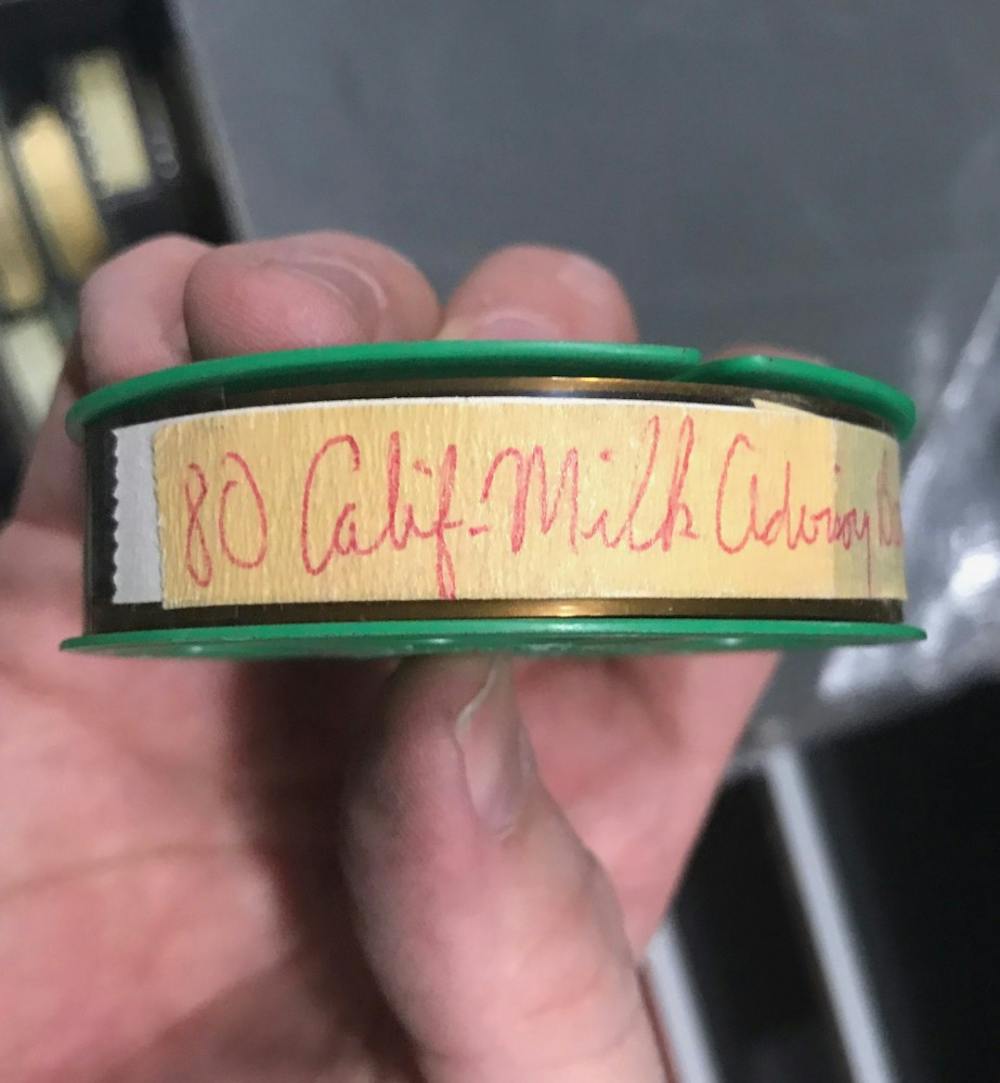Andy Uhrich sat in the dark rewinding a tape of commercials, a sound similar to record scratches filling the room as the long filmstrips slid over a spinning disc.
Black-and-white images flashed across the screen, then paused on a boy with a cardboard box as Uhrich, a film archivist, took his hands off the table.
“As you know, there is a coin shortage,” the commercial’s narrator said.
“Wait, I didn’t know that,” Rachael Stoeltje, director of the IU Libraries Moving Image Archive, said.
Stoeltje said tidbits like finding out when a coin shortage occurred are just some of the things researchers can glean from the archive’s new collection, which features an estimated 80,000 to 100,000 commercials.
Temporary film archivist Katie Lind said the commercials can be used for research in almost any field, including gender studies, food policy, politics, film history, advertising and even economics, such as in the event of coin shortages.
The collection includes TV commercials that are entered to compete for the Clio Awards, which Stoeltje describes as the Oscars of advertising, in the 1960s, '70s and '80s.
The reels, which are on 16 mm and 35 mm film, were stored in a warehouse in New York City since 1992, before London International Advertising Awards bought them and donated them to IU, according to a December press release from IU Newsroom.
“They were just sitting there unused, just piling up dust,” Stoeltje said.
Stoeltje said the University has digitized around 100 of the commercials, 45 of which are available for online streaming.
“This is really the library wanting all these commercials and resources to be available for research and scholarship,” Uhrich said. “We want it out there.”
Uhrich said digitizing these commercials is also a means of preserving the artifacts of human culture.
Another way of preserving culture is holding onto the equipment used to create cultural works, Uhrich said.
The archive is currently cleaning and storing 200 new cameras and 44 projectors donated by Washington, D.C. archivist Alan Lewis. Some of the equipment dates back to as far as the 1920s.
Stoeltje said the archive is trying to preserve the technology just as much as the images themselves.
Doing so means people can access old tapes sitting in their attics that can only be played on older projectors, she said. The equipment can open the locks to artifacts that would otherwise just collect dust.
Uhrich said keeping older equipment is part of understanding how society got to the point where video is everywhere.
“This is part of that story, our story,” he said.
Stoeltje said the old equipment is also beautiful and contributes as much to art as it does to history.
Lind said some of her favorite commercials in the reels are the ones advertising processed meats.
“They were just very excited about their processed meats,” Lind said.
Stoeltje said the processed meat commercials are an example of how commercials are keys to explore the culture and values of the societies they were created in.
“There was this idea that they were cutting out all those pesky natural things to make something quicker, so it shows how our culture values the faster and easier,” Stoeltje said. “Now, the trend is to tout how natural something is, so it’s really come full circle.”
Uhrich said one of his favorite commercials is from Hamm's beer. In the commercial, a man wanders with his pet bear before stopping at a bar for some Hamm's beer.
He said he thinks the commercial is based on the '70s TV show, "The Life and Times of Grizzly Adams."
“But you see, we wouldn’t get that reference now, but it was big enough to be in a commercial then, so it really is just a peek into pop culture of that time," he said. "That was a cultural moment at the time.”
Uhrich said commercials represent an underserved area in media history because people often do not look at them from a scholarly perspective because they are seen as lesser than film and TV.
He said a lot of well-known TV and film directors, such as Jerry Bruckheimer (producer of "Armageddon," "Pirates of the Caribbean: Dead Man's Chest," "Remember the Titans"), also worked in ads. Many of them would make the money to fund their other work by doing commercials, he said.
A lot of more experimental, avant-garde film styles entered the mainstream through ads, Uhrich said. As a result, commercials serve as a way to understand changes in styles through time.
“Ads could be a little more creative, a little more adventurous, a little more surrealistic than mainstream TV and movies,” he said. “Then they kind of bled over and influenced TV and film as well.”
Lind said the reels also include commercials from 85 countries. While she has not seen a lot of the international commercials yet, she said she enjoyed watching some of the Japanese ones.
Uhrich said the commercials are a treasure chest for learning about cultures around the world through time, but only time will tell how researchers and scholars will put them to use.
“The options are endless,” he said.




